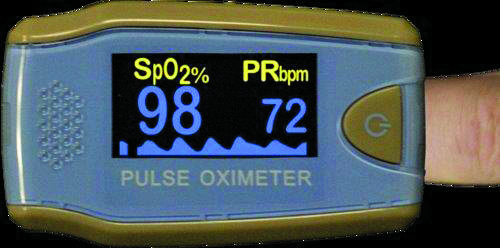
As the COVID-19 pandemic continues, people worldwide are adjusting to new norms. Social distancing, wearing face coverings and remote school and work are just a few. Many medical professionals, including respiratory therapists like myself, have deemed the use of a pulse oximeter essential, as they have witnessed its lifesaving potential over the past few weeks. A pulse oximeter is a medical device that reads oxygen levels in the blood. Demand for this handheld medical device has surged to the point that it can be hard to even obtain them at times these days.
Why is the pulse oximeter now in more demand than ever? It’s because of the way COVID-19 attacks a person’s body. Unlike other illnesses where a person feels sick immediately and tries to treat symptoms with medicine and rest, COVID-19 attacks a person by causing COVID pneumonia, in which the air sacs in a person’s lungs slowly fill up with fluid. A person may start to experience lower and lower blood oxygen levels without even noticing, because it happens so slowly over time. The danger of low blood oxygen levels, also known as hypoxia, is that in severe cases, it can interfere with the heart, brain and other organs functioning properly.
Only by using a pulse oximeter can a person check their oxygen levels from their own home, without having to go to a lab or hospital and have a painful procedure done. The way a pulse oximeter does this is by shining a light on a person’s fingernail and quickly measuring the amount of oxygen in their blood.
A normal and healthy pulse ox saturation ranges between 94-100%. When the COVID-19 surge first started to happen, people were coming in to emergency rooms with saturations below 80. Amazingly, the patients didn’t always complain of shortness of breath. They had literally gotten used to being starved of oxygen. By having an oximeter at home, a person can easily and regularly check their oxygen saturation, and if they notice a steady and consistent drop, notify their medical doctor. Over the past few weeks, I have seen doctors use pulse oximeter readings as a guide to allow their patients to stay home and avoid hospitalization during COVID-19. On the other hand, many of my patients were instructed to head immediately to the emergency room once their oxygen saturation hit a certain number.
It is important to know that wearing nail polish, artificial nails or having very cold fingers could lead to inaccurate results. Another thing to be careful of is that you have a reliable oximeter. I often educate patients that although there may be lots of cheap pulse oximeters on the internet, it is very dangerous to buy them, as an inaccurate reading can give a patient a false sense of security when their health is declining.
Most homes today have a thermometer in their medicine cabinet so that if a person doesn’t feel well, they can check for fever. I highly recommend that people add a pulse oximeter to their medicine cabinet, especially as we deal with the COVID-19 pandemic.
Aaron Hoffer is a licensed respiratory therapist and president of M D Respiratory Services, Inc. He has been treating patients with respiratory disorders for over 20 years and lives with his wife and four children in Teaneck. To contact him for further information, feel free to email him at ahoffer@mdrespiratory.com.









